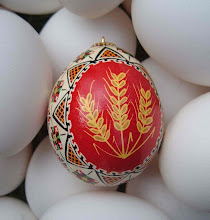Sunday, April 11, 2010
Under Lights
The lights needed for growing vegetable starts are simple and inexpensive. To start my tomato, pepper, and cole plants I use 3 sets of 4 foot flourescent shop lights side by side. Under those lights I've started 100 each of tomatoes and peppers, and three dozen broccoli/cabbage plants. I admit that by the middle of April I'm usually taking the plants outside for part or all of the day, and sometimes in early May when it's colder and rainier than I had planned on it being (meaning I didn't plan!) I've had to platoon them, growing half under lights during the night and putting them in a totally dark room during the day, and then the other half under the lights all day, and in the dark room at night. As long as they spend time in total darkness they won't get leggy, even if they have to spend a couple of days there continuously.
The real key is to have the lights be no more than 3-4 inches above the seedlings. To accomplish this I raise the lights gradually as the plants grow. Here comes the part where you should not do what I do: I rest the ends of the fixtures on books (an old set of encyclopedias), and this means that with some of the brands of fixtures the bulbs themselves rest on the books. This can't be a good thing. They never get hot, but I'm still not sure it's safe (informed opinions about this would be welcome in comments), and it would be better to have an arrangement where the lights could be lowered and raised by chains, as the fixture always comes with holes for an S hook to hold the chain. Some brands of fixtures are designed such that the metal shade extends below the lights, and these are the ones to look for if you're going out to buy them.
The light stands that are sold by gardening centers do generally have a way to lower the lights by chains, but they are very expensive. At best, you could build a modest arrangement to do this yourself. Make sure you can put at least two units side by side, as I find that there's not enough light to satisfy plants off to the side. If you're planning on putting flats under the lights you'll definitely need two-or three sets side by side. As a temporary arrangement planks or 2x4's straddling workhorses, with hooks that would let you attach the fixtures' chains, might possibly be safer than my arrangement. No matter what you do, make sure that neither children nor pets can upset the lights.
Fortunately I have a 6 foot table in a back room that I can dedicate to this project, so I'm not getting down on the floor to water little seedlings. I drape the table with 6 mil plastic, and I'm all set to go.
This picture shows the dilemma I face with just these 3 sets of lights. I have tiny seedlings 3 inches under the lights, and tomatoes that are growing right up into the lights. It's time to transplant the tomatoes, and I'll need to raise the flat of tiny seedlings so they're closer to the lights. The tomatoes are a little leggy. That's mostly because there have been days I've never turned on the lights at all (sigh), and also because I should have bought new bulbs this season, and didn't. Even though the lights still turn on, they lose brightness over time, and should be replaced every year. But the tomatoes will be fine when transplanted, and the camera angle is also exaggerating how tall they are. They tiny seedlings look okay, as you can see. (And yes, the tomatoes are a little yellower than they should be. need fertilizer)
Subscribe to:
Post Comments (Atom)





The chains for my light are attached to an overhanging shelf, but in a previous residence I had them attached to the ceiling with those screw-in hooks you use for things like hanging plants. With S-hooks and chains you can adjust the height of the lights very easily.
ReplyDeleteAmanda - It isn't practical for me to hang the lights from the ceiling in the room I've got the lights in. I've thought about attaching to the underside of a shelf, though. Does this mean you have just one light fixture wide on the shelf?
ReplyDeleteCool Site Kathy!
ReplyDeleteI will definitely enjoy perusing it.
Mary (from the garden)
Thanks Mary.
ReplyDelete